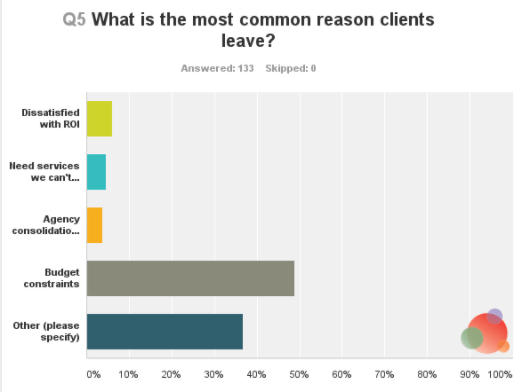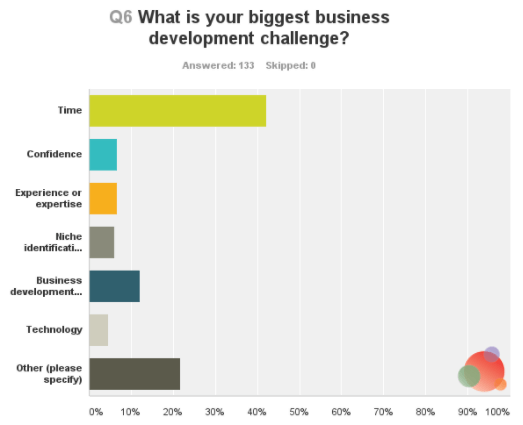 I was in a meeting a few months ago where a colleague was talking about how, in the PR industry, there is only one way for a woman to become a leader…
I was in a meeting a few months ago where a colleague was talking about how, in the PR industry, there is only one way for a woman to become a leader…
…start your own PR firm.
While that is a slight exaggeration, it is true only 30 percent of all global PR agencies are run by women.
And that’s just on the agency side.
We know on the corporate side, the percentage is much, much, much lower.
But the comment in that meeting got me to thinking—which I then took to my team: What do we collectively know about independent PR professionals, including those who run firms?
As it turns out, not much.
So we took the interwebz and asked any and all of you who work for yourselves or for agencies to help us find some answers.
We found that the number among those surveyed is actually higher—just a little more than half of the independent pros and PR firm leaders are women.
And we discovered even more interesting information, such as how few of you have proactive business development plans and rely solely on word-of-mouth and referrals to keep you afloat.
I’m going to put my mom hat on and say:
THAT IS NOT GOOD!
I’ll let you think about that for a minute, and we’ll come back to it at the end.
In the meantime, I’d like to share the four main insights we took from the survey:
- Nearly half of independent PR firms surveyed are operating without employees, either working solo or working exclusively with contract workers.
- Long-term client relationships are the norm, although many firms are engaging with companies for one-off, fixed-term projects.
- Budget issues are the most common reason cited for client loss.
- The majority of firms are relying on word-of-mouth and reactive business development activities instead of building a client pipeline through ongoing activities.
Half of PR Firms Operate without Employees
This goes back to the point my friend was trying to make: The only way you can control your own destiny, make more money, and be a leader is to go out on your own.
Which many of you have chosen to do.
But 49 percent of you are going it alone.
Completely, totally alone.
Key Findings
- That said, nearly 2o percent of you work with one or two people, either as full-time employees or contractors.
- Seventeen percent of you have three to 10 employees.
- And a rockin’ four percent of you have 50 to 100 (or more) employees.
Analysis
We live in a world where we can work with virtual staff around the globe.
This allows us to buy more time, become more productive, and build our dream businesses.
So, while nearly half of you are working alone, there is a gigantic opportunity to take advantage of this global workforce.
As Chris Ducker suggests in Virtual Freedom, take a minute to create three lists:
- Things you don’t like doing;
- Things you can’t do; and
- Those things you shouldn’t do (which is where most of my list resides).
Though many of us don’t want (or need) full-time employees, a virtual stuff is a great way to look at doing only what you are best at doing.
Expert Insight: Jodi Echakowitz
With the rapid rise of the gig economy, it doesn’t surprise me to see that the second and third largest groups of participants in the survey fall into the solopreneur and consultant categories.(Although I think these numbers could even be higher if they were consolidated, since so many in the PR industry today identify within both categories depending on who they’re talking to and within what context.)Businesses that work with independent PR consultants, or a virtual “agency” that brings together a network of independent consultants, recognize that they can benefit from the experience that the consultants have gained through many years of working either in-house or at an agency, but at a much lower cost than a traditional PR firm.For PR consultants, going the solo route means flexible work hours and income that can scale up or down. While they no longer have the security of a monthly salary, the benefits far outweigh the risks. I took the solo leap almost 16 years ago and have built a virtual team over the years that is now comprised of 14 independent consultants. I have not looked back on that decision once (although at the time it was a scary move thanks to a combination of the dot.com bust and pregnancy hormones.)From my point-of-view, I choose specifically to work with independent consultants with at least 10 years of in-house or agency experience. They are self-motivated, and because they don’t need any training, coaching, or hand-holding, they are ready to support clients straight away. They’ve also typically found their footing career-wise, so they love the work they do and don’t focus their efforts on finding new opportunities to earn more money or a higher level title. At the same time our clients benefit from a highly experienced team.
Long-term PR Firm Relationships are the Norm
The good news is that, although many of you are going it alone, you have a great client tenure.
Twenty-six percent of you have had clients between three and five years.
And 24 percent of you keep your clients for one to two years.
Right there in the middle, at two to three years, are 21 percent of you.
The outliers are less than a year and more than five years.
Key Findings
While you tend to keep clients around, the number you have tends to be five or less.
- Forty-one percent of you have three to five clients, which is likely how it is that you keep clients as long as you do. You are able to provide personal attention and high-level expertise.
- There are 26 percent of you who have six to 10 clients.
- The rest of you fall in the one to two or 11 to 20 or more range.
Analysis
In a world where the client and PR firm tenure is three years or less, this is very good news!
Forty-one percent of you have client tenure that lasts longer than three years, and beats the industry norm.
While you may have had to go out on your own to be taken seriously, it’s working!
Your clients do take you seriously and, based on the numbers alone, you have created great partnerships.
Expert Insight: Leslie Eicher
- Demonstrate a deep knowledge of your company, products and services, and industry.
- Provide objective counsel…even if it’s not what they want to hear.
- Work closely with all stakeholders to ensure the PR strategy is helping to support all goals — business, sales, product development, marketing, etc.
- Stay on top of new approaches, tools, and information that increases your value as a counselor.
- Articulate and deliver on measurable goals.
Budget Tends to Be the Cause for Client Loss
Although client tenure doesn’t seem to be affected by the current global political uncertainty, the most commonly cited reason for clients leaving is budget constraints.
A number of respondents noted there being a “race to the bottom” in client retainers, with many not understanding the value of PR.
This is likely due to a lack of agreed upon metrics in place at the start of PR engagements, or an inability on the agency side to insert measurable outcomes into the work being done.

Key Findings
- Forty-nine percent of you said clients leave because of budget constraints.
- But 37 percent of you said it was for reasons other than what we have listed.
- Other reasons listed include: Change in client leadership, project ended, services taken in-house, priorities change, and PR is not a priority.
Analysis
Of the 37 percent of you who said clients leave for a reason other than what we had listed, a shocking 78 percent said it’s because the project has ended.
Several PR firms reported they take on project work (sometimes at a loss) as a business development tactic, with the intent of pitching a retainer if the work goes well.
That many projects do not turn into ongoing relationships demonstrates that many organizations still view PR as a “nice to have” activity that can be turned off and on in support of a campaign, rather than an integral part of their business growth activities.
Expert Insight: Roger Friedensen
 Although some agencies view a change in leadership as an inevitable road to being replaced, others have successfully navigated leadership changes with their retainer intact.
Although some agencies view a change in leadership as an inevitable road to being replaced, others have successfully navigated leadership changes with their retainer intact.
Here are my tips to fight to keep the business—and win:
- Move quickly, but politely to introduce yourself and your firm in person to the new team and emphasize that your focus and loyalty are to the organization/department, not any specific individual.
- Demonstrate that your goal is to provide communications counsel and support that will help the new leadership get the work done that needs to be done in the most cost-effective and intelligent way.
- Don’t take anything for granted, and be very, very clear in saying that you understand what was may not continue to be and that you would consider any opportunity to “contribute to the cause” an honor and pleasure.
- Seek personal meetings whenever possible and regularly send ideas and “FYI” articles of interest to the new leader to demonstrate you are actively and always looking out for him/her.
- Be confident in the depth and breadth of your knowledge of the organization and its environment, but avoid sounding arrogant, presumptuous, or entitled at all costs.
- Show you are flexible and are eager to adjust what needs to be adjusted and implement new techniques and ideas.
- Ask a lot of questions. And make them smart, insightful questions that demonstrate you think strategically about today and tomorrow.
- And finally, be pleasant, respectful, humble, and fun. Be someone who you would want to hang around with and would trust with your reputation.
Only 25 Percent of You Have Business Development Plans
Alright, this is where we need to have a serious talk.
(Mom hat again.)
How many of you lived through the Great Recession?
I did, and I will tell you right now the only reason my business survived is because we did not rely on referrals to fill our pipeline.
Sure, we all benefit from referrals—and that’s fabulous!
But it cannot be our only business development plan.
Because things such as the Great Recession or a war or a terrorist attack or even the flu can take us down for days, weeks, months, or even years.
Key Findings
- While word-of-mouth has the benefit of being quick to close, several respondents noted that its spontaneous nature can lead to a “feast or famine” situation.
- The primary trends uncovered through responses to the question, “What help or change in circumstances would make a difference in your business development process?” involved having a dedicated business development person.
- One way some respondents have found to make that time is by increasing passive income.
Analysis
After the Great Recession nearly put us out of business, I decided we needed to have seven different revenue sources to help us when that happens again.
Today we have:
We’re working on our sixth and seventh sources right now.
One will start driving revenue for us in Q3 and the other not until Q1 of next year.
So you can see it’s not an overnight kind of thing.
Start thinking, right this second, about how you’re going to add other revenue sources.
And, more importantly, how you’ll generate the inbound leads that lead to all of your creative revenue sources.
You want a fuller pipeline that isn’t reliant on word-of-mouth and referrals.
You want to be able to predict your cash flow, your client needs, hiring needs, and profitability.
To be able to generate more leads and close more clients.
Expert Insight: Dana Kaye
 I’m currently receiving passive income from online courses, my book—Your Book, Your Brand: The Step-by-Step Guide to Launching Your Book and Boosting Your Sales—, and affiliate links.
I’m currently receiving passive income from online courses, my book—Your Book, Your Brand: The Step-by-Step Guide to Launching Your Book and Boosting Your Sales—, and affiliate links.
The revenue is modest, and accounts for less than five percent of my overall total revenue.
I am always looking for new methods and tactics to grow my mailing list, run successful affiliate launches, and increase link clicks. I also love hearing from other members of the community about what’s working for them, what used to work but isn’t anymore, and other trends they’re seeing.
The 2017 State of the Independent PR Pro Industry Report
If you’d like the full State of the Independent PR Pro Industry Report, you can find it here.
As we build on this for 2018, we’d love to hear what else you’d like to include.
In the meantime, use the comments below to make a commitment to creating a proactive business development plan for yourself.
We’d love to see you in the 25 percent of PR firm leaders that work their plans—and have more than client retainers in your seven revenue sources.
And I’m super happy to hold you accountable.
(I say in an evil voice.)
So let’s hear it!




